Click here to get this post in PDF
Caring for indoor plants at home or in the workplace can be both rewarding and therapeutic, but even the most experienced plant lovers sometimes find themselves puzzled by yellowing leaves or drooping stems. The key to maintaining healthy, thriving greenery often lies in learning how to read your plants — and their leaves are one of the best indicators of their overall wellbeing. Brands like Hello Botanical make it easy to bring lush indoor plants into your home, but keeping them healthy long-term depends on understanding what their leaves are trying to tell you.
Signs of Overwatering
Overwatering is one of the most common mistakes in plant care. While it’s easy to assume more water equals more growth, too much moisture can suffocate roots and lead to decay.
What to look for:
- Yellowing leaves: Particularly at the bottom of the plant, this often indicates waterlogged soil.
- Soft, mushy leaves or stems: These are signs of rot setting in.
- Wilting despite wet soil: A counterintuitive but common symptom — the roots can’t absorb oxygen in saturated soil.
How to fix it: Allow the soil to dry out before watering again. Ensure pots have proper drainage holes, and consider repotting in fresh, well-aerated soil if root rot is suspected.
Signs of Underwatering
On the flip side, underwatering can cause plants to go into survival mode, conserving resources at the expense of leaf health.
What to look for:
- Crisp, brown leaf edges: Often the first sign your plant is thirsty.
- Drooping or curling leaves: Especially if the soil feels dry to the touch.
- Slow growth: A sign your plant is lacking the moisture it needs to transport nutrients.
How to fix it: Water your plant thoroughly, ensuring excess drains away. Establish a regular watering routine based on the plant type — succulents and cacti need far less water than tropical varieties, for example.
Signs of General Stress
Plants can also experience stress from environmental changes such as temperature fluctuations, low humidity, or too much sunlight.
What to look for:
- Brown or scorched spots: Often caused by too much direct sunlight.
- Leaf drop: Common when a plant is moved or exposed to cold drafts.
- Pale or faded leaves: Could signal insufficient light or nutrient deficiencies.
How to fix it: Try to replicate your plant’s natural environment as closely as possible. Adjust light exposure, maintain consistent temperatures, and feed with a gentle fertiliser during active growth periods.
Nurturing Healthy Leaves Year-Round
Once you learn to read your plant’s leaves, you’ll be able to catch potential problems before they escalate. Whether you’re tending to a fiddle-leaf fig or a compact desk fern, staying observant and responsive is key to success. With a little patience, you’ll soon enjoy a home filled with happy, healthy greenery that thrives under your care.
You may also like: LED Grow Lights a Complete Lighting Solution for Indoor Plants
Image source: elements.envato.com

